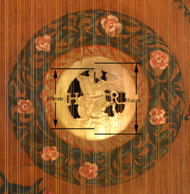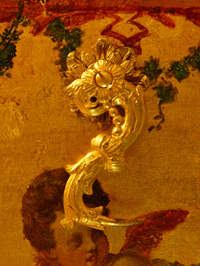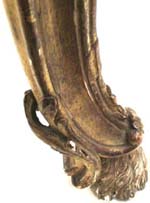Click on the images below for more details
![]()
The harpsichord after cleaning but before restoration
A detail of a foot of the stand
The lid painting after cleaning
![]()
A Franco-Flemish double-manual harpsichord,
![]()
A
Brief Musical and Decorative History of the Franco-Flemish Harpsichord
|
|
State 1 - 1617. The original state is typical of a classic Flemish double-manual harpsichord made in Antwerp. The upper manual compass was C/E to c3 at normal pitch, the lower-manual compass was C/E to f3 a fourth lower. Such instruments are best known among the output of Ioannes and Andreas Ruckers, but it can be shown scientifically that the instrument is not by the Ruckers as it has numerous features that are totally different from normal Ruckers practice. |
|
|
State 2 - ?c.1680?. ‘Ghost State’ - place and date unknown. Aligned keyboards with a compass G1/B1 to c3 with 50 notes. No direct evidence has been found on the instrument of this state, but this is the usual first alteration to State 1, and the next state would follow logically on from this. |
|
|
State 3 - c.1735, Paris. Compass G1/B1 to d3 with 52 notes. One note was added at the top and one at the bottom of the compass. The surviving upper registers and lower guides all indicate a 52-note compass before additions to them were made in 1750, and then again later. There is no evidence of what the decoration was like at this stage.. The genuine ‘HR’ rosette may have been inserted at this date to make a new buyer think the instrument was by Hans or Ioannes Ruckers. |
|
|
State 4 - 1750, Paris. The bass compass was extended down by 6 notes from B1 to F1 to give a compass from F1 to d3 with 58 notes. Most of the case decoration and the majority of the inner and outer lid decoration date to this period. The paintings of the lid and case have been attributed to François Boucher (29 September 1703 – 30 May 1770) with the ornaments around the painting attributed to Christophe Huet (1700 - 1759). The bottom jacks of all three surviving rows have the date ‘1750’ written on them, and these and the 57 jacks above them all belong together and to this state. The musical part of this state may be by François Étienne Blanchet II (c.1730-1766), ‘facteur des clavessins du roi[sic]’ (see point 2 below). |
|
|
State 5 - c.1770, Paris. The compass was widened in the treble by 3 notes from 58 to 61 notes to give F1 to f3. This is the present compass and the classic compass of an 18th-century French harpsichord. In the process of widening the instrument, the cheek was shortened, putting the figures painted in 1750 on this side slightly off-centre. In the process the bentside was lengthened and the join at the treble end of the bentside was disguised with a kind of floral decoration.
|
State 6 - 1786, Paris. The compass of the keyboards of this state was the same as in State 5 above. But the instrument was ‘modernised’ at the time when harpsichords were competing with pianos as ‘expressive’ instruments. It was given a peau de buffle register and a genouillère to enable the player to ‘swell’ and change the registration without taking his/her hands off the keyboards. Various internal blocks for the genouillère still remain as evidence of this state. The front surface of the lower full-width belly-rail was inscribed “[Re]fait par N. Hoffmann a Paris 1786” [Nicolas Hoffmann, active 1786-1790] which therefore also gives the date and author of this ravalement. The peau de buffle upper guide from this state was re-used as a lower guide in the 1971 ‘restoration’ by Roberto de Regina in Buenos Aires (see below). De Regina found the calling card of Jacques Barberini [active 1782 - 1791] on the baseboard and so Barberini must also have had a hand in this state, but it seems now impossible to say which features belong to Barberini and which to Hoffmann.
General notes: There is rigorous scientific evidence that the instrument was originally made in Antwerp and that it uses the Antwerp duim - the thumb or inch - in its design and construction. However, most of the original design principles are quite unlike those found in the instruments built in the usual Ruckers/Couchet tradition and these make it clear that it was not originally an instrument from the Ruckers workshops.
The various alterations to the width of the case are visible on the surfaces of the case, lid and front flap, although sometimes these are disguised and covered by later decorations. The extensions to both ends of 2 of the 3 surviving registers and to the 3 lower guides are clearly visible, and the number of notes added at each stage tallies perfectly with the above compass history.
There can be no doubt that the surviving case and lid decorations are all from the 18th century with the exception of some badly-painted additions made in 1889, when the instrument is known to have been owned by Louis Tomasini in Paris. These late decorations are similar to those of Daniel Merlin who decorated some other instruments by Tomasini and others (all now in Berlin) in 1889 for the Exposition Universelle for which the Eiffel Tower was built, and who also decorated some 'Roccoco' pianos by Pleyel.
The
dates that can be associated with this instrument with complete assurance are
the following:
1. 1617 - the date of construction is given in the first edition of the Dictionary of Music and Musicians, Ed. George Grove (Macmillan Pub., London, 1883) p. 197 which lists the instruments then thought to be by the various members of the Ruckers family:

The publication of this entry [1883] follows shortly after the date 1878 when the instrument was known to have belonged to 'M. Pilette' in Brussels. The source of the information is Victor Mahillon, one-time director of the Brussels Museum of Musical Instruments. The statement: ‘Paintings in Vernis Martin, lately removed’ in the above entry almost certainly refers, not to the external decoration which clearly still exists, but to the soundboard decoration which, along with the date, was removed. This is confirmed by the later editions of Grove's Dictionary which do not give the date but list the instrument as ‘n.d.’ = no date The soundboard was later decorated (without a date) by Mabel Dolmetsch when it belonged to Arnold Dolmetsch. The subsequent entries in the later editions of Grove's Dictionary make it clear that this entry does in fact refer the same instrument.
2. 1750 - the date written on the first jack of all three of the surviving rows of jacks with 58 jacks in each row. This number of jacks corresponds to the width of the instrument when the tail, spine and front board ornaments and the inside and outside of the lid ornaments and paintings were painted. Many features of the musical alteration which were made to the instrument in 1750 are of absolutely superb quality so that it is at least possible that the musical alterations to the instrument made then is by François Étienne II Blanchet, who had the title Facteur des clavessins du Roi. This would not be surprising if the instrument was decorated by François Boucher, one of King Louis XV’s favourite painters.
Click here to see a larger image of the date 1750 on the jacks.
3. 1786 - the date written by Nicolas Hoffman on the front surface of the full-width lower belly rail and visible with the keyboards removed: "[Re]fait par Nicolas Hoffmann a Paris 1786". In 1786 the instrument already had a full 5-octave compass from F1 to f3. By this date Louis XV was dead so the instrument may then have belonged to Louis XVI. Jacques Barberini may also have worked on the instrument at (or around) this time as his calling card was found on the full-width ravalement baseboard
4. 1878 - belonged to one M. Pilette (I can find nothing about this person) in Brussels according to the first edition of the Dictionary of Music and Musicians (see above).
5. 1889 -1892 - the period when the instrument was owned by Louis Tomasini and when he ‘restored’ the instrument, added to the 'extra' elements to the case ornaments and probably had the soundboard painting removed. He is known to have organised concerts in Paris on ‘The Gold Harpsichord’, and he made copies of the instrument on which concerts were also given. This is probably the date of the stand since other instruments have stands in a similar style made during this period.
- Grant O’Brien, April, 2017
![]()
Important
Features of this harpsichord
![]()
Details of
the original state of the instrument
![]()
Details of the eighteenth-century states of this harpsichord
Details of the modern history of this harpsichord
![]()
A problem encountered in the ethical restoration of this harpsichord
![]()
Return to the main page of this section
![]()













